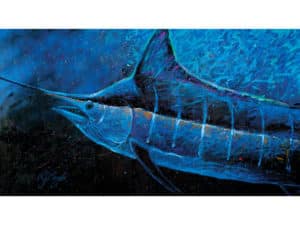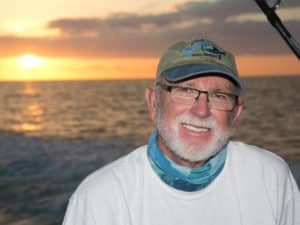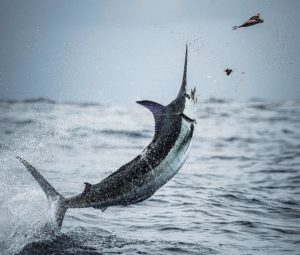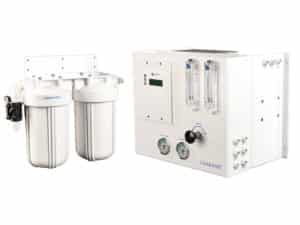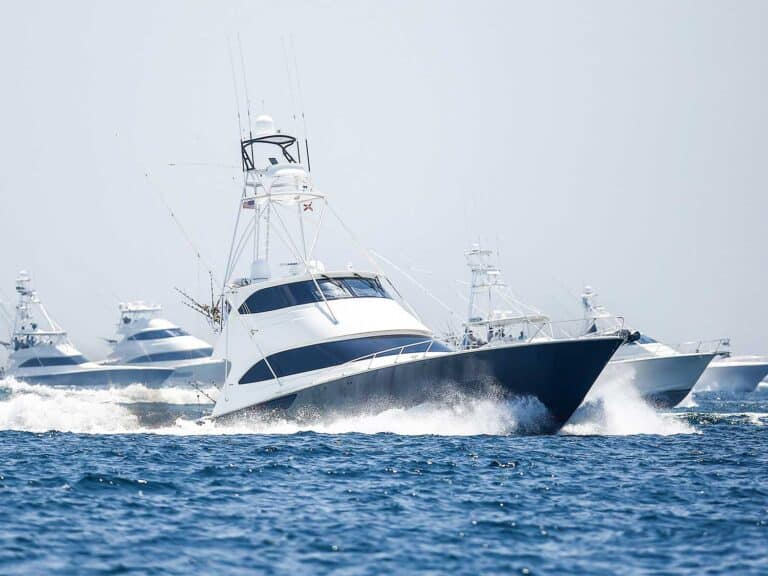The original mates on Hooker, Trevor Cockle and John and David Cochrane, were two seasoned Texas fishermen who signed on for the first leg, which ended in Africa in 1988. David Cochrane joined the crew in January 1988 in Puerto Rico, and he says that of all the places he’s fished, “Africa was the most memorable on many levels.”
Longtime client Rufus Wakeman of Stuart, Florida, couldn’t agree more. “I fished four times on Hooker and even rode with them during a repositioning trip from Hawaii to Cairns, Australia — quite an experience,” he says. “In those days, you could charter the mothership and sport boat for $1,400 a day. Split with a friend ($100 extra for each guest), we’re talking $750 a day to live aboard and fish the Great Barrier Reef. I would have taken out a loan if I had do.” Fishing Dakar, Senegal, in June 1988, Wakeman caught a 65-pound, 9-ounce sailfish on 12-pound tippet, which was one of the boat’s first fly records. “What I remember about that trip was that sitting in the air conditioning on the mothership felt like America, but as soon as you opened the door, the sights and, oh, my, the smells of Africa engulfed you. The amount of pollution in the marina was ungodly. There was 2 feet of dead birds, garbage and who knows what else in that water.”
During the 1987-1988 leg, they not only fished the Ivory Coast and Senegal but Cape Verde as well, where David Cochrane lost the tip of his finger. “With no doctor to treat it, the guys bandaged it as best they could and got me out on a plane to Dakar,” he says. “From there I flew to Lisbon and back to the States, where a plastic surgeon did a skin graft that grew a new fingertip.”
Trevor Cockle left in 1988 for a 16-month break, and David Cochrane’s brother, John, and sister-in-law, Ann Marie (they celebrated their 10th wedding anniversary on Madam), the boat’s engineer and hostess, left to go home and start a family. Now a yacht broker and the founding director of the Legends Tournament and Texas Saltwater Fishing Hall of Fame, John Cochrane recalls those two years as “the fishing trip of a lifetime.”
Jerry and Barbara Parsons of Tampa, who Dunaway met when they were working for Joe Lopez on the 85-foot Gallant Lady in St. Thomas, took their place. “I actually flew over early to help bring the boat back from Africa,” says Jerry Parsons, who joined the operation in 1989 and stayed until 1997. Leaving Cape Verde in late September, Smith steered the mothership between two tropical depressions coming off Africa. They arrived safely, with the sport boat riding piggyback on a dry-dock cradle aboard the stern of the 110-foot Madam. When they got home, however, Parsons re-engineered the cradle to make it safer to load. Parsons became captain of Madam in 1991 when Smith left. Parsons later removed the dry dock and added more staterooms on the back deck and an additional 8,000-gallon fuel tank that gave Madam a 48,000-gallon capacity. “After that, we towed the boat so we could sell fuel to other boats.”
Although they loved their jobs, the hours were long, Barbara Parsons says. Typically, she was up at 4:30 a.m. preparing lunch and breakfast for guests and the crew before beginning her cleaning chores. In Australia, she got some help from a yacht steward and chef named Sally Jenyns, the youngest of a famed Australian fishing family that includes Ron and Bo Jenyns. Jenyns joined for the experience of crossing the Pacific from Cairns to Mexico. Between those points, they spent five months in Tahiti with Capt. Peter Wright running Hooker. Jenyns now is a well-known cookbook author and television personality. Dunaway says that the guests loved her sunny disposition and savory leg of lamb. Jenyns’ favorite story from her adventures on Madam is that of arriving in San Diego and being declared an illegal alien, due to a visa mix-up in Mexico. “After spending a day guarded from leaving by U.S. customs officials, superman Jerry Dunaway convinced officials to let him take me by car to Mexico to clear up the mess so that I could legally enter the United States,” she says.
Provisioning Madam was a herculean task. “Jerry Dunaway bought his meats and staples wholesale from the States and Panama,” she says. “But we still had to buy fresh fruits and vegetables in local markets. To me, Tahiti had the best.” Fresh fish was, of course, abundant. “Guests liked the ceviche and ahi tuna rolls we made,” she says. Another staple was Parsons’ famous tuna-noodle casserole. After four years, she left the boat and settled in Costa Rica so that she and Jerry could spend time together when the boat was there. “He is one of the best marine mechanics and engineers we had on the boat,” Dunaway says. Parsons now regularly pilots a 165-foot Trinity megayacht in the Mediterranean. After attending the Hooker reunion last March, Parsons had this to say about Hooker’s legacy: “Fishing the world continuously for 25 years like they did let this group accomplish things that had never been done before.”
Accomplishing the impossible was Capt. Trevor Cockle’s specialty, says Dunaway, recalling the time when Cockle and Randy Baker rebuilt Hooker’s Cummins 903 engines in the Cocos Islands for the first of many times. “Challenges came up on a daily basis fishing remote corners of the world, where the closest town usually was off the chart,” Cockle says. “Challenges like having a seaplane full of guests crashing, or rebuilding the engines of Hooker in two and a half days 300 miles off the coast of Costa Rica. It’s one thing having to do the work yourself; it’s another trying to find parts for a job of that magnitude in a remote area.” There also was the time he pumped 35,000 gallons of fuel from a tanker into the mothership in the open ocean, 200 miles off Africa. “It was like we were Marines. The logistics were mind-boggling. Imagine having to run 300 miles one way to pick up guests and supplies, and turning around a few days later to take them back. In three months fishing the Cocos Islands, I put 6,000 miles on Hooker doing just that. The challenge and adventure is what kept me on the boat all those long years.”
Skip Smith’s light-tackle-record résumé includes 49 world records, and Trevor Cockle logged more than 60 on Hooker and, later, on God’s Favor. Cockle worked for the operation’s two owners, Dunaway and Dr. Craig Morgan, who bought the boat in 1999 when Dunaway decided to build a new G&S and house in Madeira. “Dr. Morgan enjoyed the sport just as much, but was never as goal oriented about catching records,” Cockle says. “In the early days, our success was due to Jerry creating a team atmosphere that emphasized the importance of each person’s role. To bring his vision of a world-class record-seeking operation to fruition required the utmost dedication from the crew and from him to us. Mutual respect and dedication is what made it work. Without that, it would just have been another boat.”
On both Hooker and Madam, and later on God’s Favor and God’s Will, the crew often went beyond the call of duty, like putting in 18-hour days to prepare for the next trip, or standing at the transom for 21 hours with Charlie Tombras battling a blue on 12-pound tippet. “Nothing like helping Bill DeGraw catch a 1,337-pound blue marlin at Ascension Island, or those 20 blue marlin in one day off Cape Verde, would have been possible without two very supportive owners, amazing charter guests and incredibly talented crews that gave us an edge over other boats. I always felt if I could just raise one more beast behind the boat, they would take care of the rest. Good crews and mates made even the most grueling schedule — like working 70 days straight fishing Panama — possible,” Cockle says.
The camaraderie was another reason for the team’s success. For Ronnie Fields, that included shared moments with Randy Baker stretching out for the wire to take 20 blues in 1997 off Cape Verde. Trust and friendship also made long transits bearable, such as the 26-day steam when the sport boat was towed from the Canary Islands to Panama City, Florida. Towed 600 feet behind the mothership, Hooker rode huge swells for several days, making delivery of hot meals cast back in a plastic bag all the more challenging. Fields says that his two-year run on Hooker was one of the best things that could have happened to him, and a way to heal after the personal tragedy of seeing his best friend and fellow deckhand, Chris Bowie, pulled overboard and drowned while wiring a blue marlin off North Carolina. Fields actually had hung up his gloves when Jerry Dunaway called, inviting him to join Hooker. Wiring hundreds of fish rekindled Fields’ passion for fishing. More importantly, he learned the light-tackle boat handling and pitch-baiting skills that have served him so well, as he’s won tournaments from Ocean City to St. Thomas on Big Oh. “Traveling across oceans around the world was a great education for what I’m doing now,” he says.
Fields’ fondest memory from those years was not gaffing Charlie Tombras’ 16-pound tippet, 208-pound Atlantic blue marlin, but harpooning a swordfish they spotted tailing in glassy water off the Azores. “We tried to bait it, but it wasn’t biting, so I put together a harpoon and stuck it on the first try and transferred the fish to a rod for our owner, Craig Morgan, to catch,” he says. “He fought the 638-pound fish for two hours and 45 minutes before landing it.” Fields says it was personally satisfying, because getting a big one like that on a harpoon is a lost art. “Fishing light-tackle records like we did, there was no room for error. The bar is set so high in terms of knots, making sure that hooks are sharp and gaffs set, it made me a better tournament fisherman.”
In the 25 years of Madam and Hooker (later God’s Will and God’s Favor), there were many life-and-death moments. “Things got dicey from time to time,” Capt. Scott Levin says, recalling the day that he and Skip Smith, Deborah, Jerry and mate Greg Mercurio took the 17-foot tender out to try for a roosterfish record in Costa Rica. Levin, who spent close to three years on the boat, starting in 1988, says that fishing the big swells that form at the mouth of the river wasn’t the smartest idea. “We should have paid better attention,” he says. “Jerry and Deborah were having a blast, climbing on top of one another to see who could catch the first 2- and 4-pound rooster record, so we didn’t see the 10-foot wave cresting behind us. When I came to the surface, I saw Greg and Skip 75 yards offshore. Deborah popped up next to me in the shore break. I saw Jerry struggling and yelling for help a short distance away. None of us knew that Jerry was not a strong swimmer and was panicked. I’m a strong swimmer and had been trained in lifesaving, so I was able to calm him down and turn him on his back to swim him from the shore break that was pounding us at that point. Eventually, by swimming parallel to the current, we got into calmer water, where a local fishing boat rescued us and took us back to Madam. Skip, Greg, Jerry and I later took Hooker to recover Mako from the beach,” Levin says.
For Capt. Randy Baker, who Cockle calls one of the most meticulous mates he’s ever worked with, the most vivid memory from the 11 years he spent with the Dunaways was of Deborah perched on the transom of Hooker with a cigarette in a holder dangling from her mouth as she filed and painted her toenails blood red, and then seeing her chuck it all overboard whenever a fish came up. “I can’t count how many times that happened,” Baker says.
Now 45, Baker joined the crew at 23, in 1991, and oversaw the cockpit until 1999, when the Dunaways sold the boat and hired him to run their new G&S Hooker in Madeira. In 1989, Baker was introduced to Capt. Skip Smith during one of his visits to G&S Boats near his home in Destin.
“Skip suggested I submit a résumé to Jerry, who I finally heard from two years later, after Skip went to work for Marg and Dick Love.” Baker joined the boat in Cabo San Lucas shortly after Trevor Cockle took over as captain in Tahiti in 1991. “I took Scott Levin’s place after he left to work with Skip on Sound Machine.” California native Curt Schloderer also started that year. “They worked together like a Swiss watch runs, taking bait-and-switch to the next level,” Dunaway says.
Only three years apart, Schloderer was a West Coast guy with a sterling pedigree that included a couple of seasons with Kona legend Capt. Randy Parker, and was recommended to Dunaway by Capt. Jody Bright, who’d previously worked on Hooker.
“More so than any boat I ever worked on, Capt. Trevor was driven to succeed. He would give it 120 percent every day, fishing from sunrise to sunset and beyond,” Schloderer says. “Randy and I fed off his energy, trying to hold on as long as he did.”
Trevor Cockle says that a lot of his energy (“if that’s what you want to call it,” he says) was due to his excitement every day that he fished, about what they might catch. “For me, the job was never routine. I wanted to catch more than anyone else and never stopped trying,” Cockle says.
In the four and a half years that Schloderer and Baker lived and fished together on Hooker, they learned to compromise. “Sometimes tempers flared over rigging, and Trevor would have to mediate,” Schloderer says. “He’d been through it himself with Skip, so he was always fair. Randy definitely was more serious, but by my keeping things light, we got along good.” Mates on Hooker lived on board the boat. “We each had our own stateroom, and that helped a lot,” Baker says.
“I think we clicked because we were both neat freaks, especially in the cockpit, where we developed pretty much a seamless routine that others emulated,” Schloderer says.
Baker says that the Hooker crew put in long days. “We’d be up at 5 a.m. rigging baits to get the boat ready, because we fished from daylight to 4 p.m., if we didn’t have a fish on,” he says. After cleaning the boat, they had to be on the mothership for dinner at 7 p.m. “Jerry insisted that the crew eat with guests. He felt like it helped build relationships, which of course it did. Depending on the guests, sometimes we played this Cajun poker game, called Booray, after dinner. Those nights were late nights. Normally, we crashed by 9:30 so that we could start all over again the next day.”
“Targeting world records, we became very efficient,” Schloderer says. He left in 1996 to work on the Texas-based Helder Skelter and Hollo Kai (the former French Look mothership) for 15 years before taking his current job as co-captain with his brother Carl on Paxon Offield’s Kelsey Lee in Catalina, where he says he and his brother and the owner work closely as a team, much as he did on Hooker. “It’s what I enjoyed most about my time fishing with Jerry Dunaway,” he says.
The team concept still resonates today among crew members and the Dunaways, who share a bond of fraternity and stay in touch. Jeff Fay is one who remains close to them. Fay caught Dunaway his first Pacific and Atlantic blue marlin. “Jerry may have been a greenhorn in the early ’70s when he started with me in Kona, but he was motivated to improve his fishing performance. For us, it’s been a real friendship, which I know that he and Deborah share with their many crew members.” For his part, Dunaway says that there was no other captain he would have considered when it came time for Deborah to catch the final spearfish of her standing world-record-billfish Royal Slam. “Fishing with Jeff on the Humdinger at Kona, we accomplished that goal not once but twice, catching Deborah the 4- and 6-pound women’s world spearfish records — just for good measure.”
These and many other stories were shared last March as members of the Hooker team and their families joined Deborah and Jerry Dunaway to celebrate their shared 25-year history at the Hooker family reunion. Mike Leech, formerly president of the IGFA and at one time a fishing guest on the boat, says that there had never been a relentless effort to set billfish records until Jerry and Deborah put together Madam & Hooker, and the expertise of their crew and an unlimited budget combined to rewrite the record books. “Deborah, you held IGFA world records in every billfish category at the same time! That, to me, ranks as the most incredible fishing accomplishment of all time,” Leech said.
Mutual respect was the theme of the night, as Deborah and Jerry Dunaway thanked their former crewmen for their years of sacrifice and long hours. “I can only imagine the frustration you had teaching a newcomer like me to fish,” Deborah said. Trevor Cockle ended the night by thanking the Dunaways for allowing him to start out as a mate and work his way up to captain and manager of the operation. “I’m grateful for the days I spent on these boats, which by far were the best times of my life; for that matter, they were most of my life,” the Palm Beach-based captain said. (He left the boats in 2008, when they were individually sold.) “We got to see a large portion of the world and met some great people and had experiences that will last us a lifetime,” Cockle said.
“What came out of all the war stories at the reunion,” Skip Smith says, “was the passion for fishing and the love we shared. People always ask what made us succeed. Our desire to catch billfish as no one had ever done was our bond, but generosity is what made this team great. We accomplished feats that were beyond even our expectations. Being part of Madam and Hooker was the kind of opportunity that only comes along once in a lifetime.”
